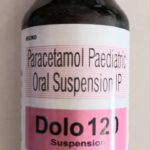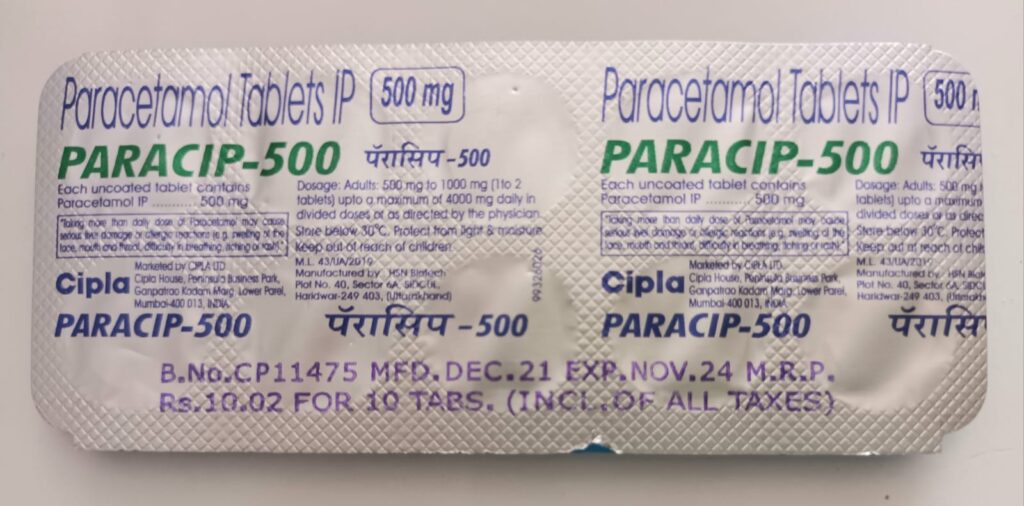Paracetamol- number 1 best drug/medicine for fever
Reviewed by Dr Bipin B. 
-
- Drug class: NSAIDs
- Generic name: Acetaminophen(Paracetamol)
- Deethylated active metabolite of Phenacetin
- Brand name: Paracip 500, Paracip 650, Paracip 150 mg drops, Paracip infusion, Dolo 650, Dolo 500, Dolo 250mg syrup, Dolo 120mg syrup, Dolo Drops, Crocin, Metacin, Calpol 500, Calpol 650, Calpol 250mg suspension, Calpol 120mg suspension, Calpol drops, Calpol T, Pacimol drops, Pacimol Suspension, Pacimol DS Syrup, Pacimol 500, Pacimol 650, Pacimol MF 125 Syrup, Pacimol Active, Pacimol MF, Ibugesic ASP,
1.introduction- Paracetamol (Tylenol/Dolo/Crocin)
Paracetamol, or acetaminophen, is a widely available over-the-counter medicine to relieve pain and reduce fever. It belongs to the class of drugs known as analgesic and antipyretic. It is commonly available in tablet, capsule, liquid, injection, and infusion forms, which makes it convenient for different age groups and conditions.
2. History
Paracetamol has a fascinating history that dates back to the late 19th century. It was first discovered in 1877 and later introduced as a medicine in the 1950s. Since then, it has become one of the most widely used pain relievers globally. It is popular because its effectiveness, safety profile, and over-the-counter availability has no match.
3. Paracetamol-Mechanism of action
It’s interesting to note that the exact mechanism of how paracetamol works is not yet fully understood. However, it is known to primarily inhibit the synthesis of prostaglandins in the body, which are substances that play a role in pain perception and inflammation. By reducing the production of these chemicals, it can effectively reduce pain and fever. Unlike NSAIDs like ibuprofen, it has minimal anti-inflammatory effects.
4. 5 important feature of Paracetamol:-
Paracetamol, or acetaminophen, is a widely used drug for relieving pain and reducing fever. Here are five essential features of this drug:
1. Analgesic and antipyretic properties: It is mainly used for its analgesic (pain-relieving) and antipyretic (fever-reducing) properties. It helps reduce mild to moderate pain caused by headaches, toothache, menstrual cramps, muscle pain, and other conditions. Additionally, it effectively reduces fever associated with various diseases, such as the common cold and flu.
2. Wide availability and accessibility:
It is widely available over-the-counter in pharmacies, grocery stores, and convenience stores, making it readily available to individuals seeking relief from pain or fever. Its availability without a prescription enables people to manage mild symptoms without the need to visit a doctor.
3.Safety Profile:
It is considered safe when used as directed. It has a well-established safety profile and is generally well-tolerated by most individuals. However, adhering to the recommended dosage and avoiding exceeding the maximum daily dosage is essential to prevent potential adverse effects, especially on the liver.
4. Minimal gastrointestinal side effects:
A notable advantage of paracetamol compared to non-steroidal anti-inflammatory drugs (NSAIDs) is its minimal effect on the gastrointestinal system. Unlike NSAIDs, which can cause stomach irritation, ulcers, and gastrointestinal bleeding, it has a low risk of such side effects, making it a preferred choice for individuals with sensitive stomachs or those at risk of gastrointestinal complications.
5. Suitability for all age groups:
It is suitable for individuals of different ages, including infants, children, adults, and older people. It is available in various formulations, such as liquid suspension for children, chewable tablets, and standard tablets or capsules, allowing for convenient administration and dosage depending on age and individual needs. However, it is essential to follow age-specific dosage instructions to ensure safe and effective use.
These characteristics collectively contribute to paracetamol’s widespread use and popularity as a pain reliever and fever reducer. Nonetheless, it is essential to read and follow packaging directions, consult a healthcare professional if necessary, and use paracetamol responsibly to ensure optimum benefit and minimize the risk of adverse effects.
5. Uses of Paracetamol:-
1. Fever
2. Headaches,
3. Toothaches,
4. Menstrual cramps,
5. Muscle aches.
6. Pain killer in Osteoarthritis
6. Adverse effects of Paracetamol:-
While Paracetamol is generally well tolerated, there is a risk of side effects, especially when taken in high doses or over long periods. Common side effects include
1. nausea,
2. stomach discomfort
3. rash.
4. Leukopenia is rare
5. Analgesic nephropathy: occurs after years of heavy ingestion of Paracetamol.
6. Acute Paracetamol Poisoning: In rare cases, it can cause serious liver damage if taken excessively. if a large dose is taken(>150 mg/kg or >10 gm in adults), serious toxicity can occur. Fatality is common with >250mg /kg. It is important to follow the recommended dose and avoid combining Paracetamol with alcohol or other medicines containing Paracetamol
Individuals with pre-existing liver disease or who regularly consume alcohol should consult a healthcare professional before using this medication. It is also important to disclose any other medications you are taking to avoid potential drug interactions.
7. Drug interaction
Drug interaction with other drugs has been reported, but most have no clinical significance. Hence, Paracetamol is safe to use. However, consult a doctor while taking these medicine.
8. Dosages of Paracetamol
The appropriate dose of paracetamol varies depending on age, weight, and the condition being treated. It is essential to read and follow the directions on the packaging or consult a healthcare professional for guidance. Exceeding the recommended dose can cause harmful effects. It is usually taken orally, and the dosing frequency depends on the formulation, ranging from every 4 to 6 hours for immediate release.
1. Adults: 0.5-1 gm thrice a day
2. Infants: 50 mg
3. Children, 1-3 years: 80-160 mg
4. Children, 4-8 years: 240-320 mg
5. Children, 9-12 years: 300-600 mg
The appropriate dose of paracetamol varies depending on age, weight, and the condition being treated. It is essential to read and follow the directions on the packaging or consult a healthcare professional for guidance. Exceeding the recommended dose can cause harmful effects. It is usually taken orally, and the dosing frequency depends on the formulation, ranging from every 4 to 6 hours for immediate release.
1. Adults: 0.5-1 gm thrice a day
2. Infants: 50 mg
3. Children, 1-3 years: 80-160 mg
4. Children, 4-8 years: 240-320 mg
5. Children, 9-12 years: 300-600 mg
2-3 month- 2.5 ml- twice a day
3-6 month- 2.5 ml- four times a day
26-24 month- 5.0 ml- four times a day
2-4 year- 7.5 ml- four times a day
4-6 year- 10 ml- four times a day
6-8 year- 5 ml- four times a day
8-10 year- 7.5 ml- four times a day
10-12 year- 10 ml- four times a day
12-14 year- 10 ml- four times a day
14-16year- 15 ml- four times a day
16 year and above- 500 mg tablet -four times a day
9. Paracetamol vs other pain killer
Paracetamol is often compared to other common pain relievers, such as non-steroidal anti-inflammatory drugs (NSAIDs) such as ibuprofen and aspirin. Unlike NSAIDs, it has minimal anti-inflammatory effects, making it more suitable for individuals who cannot tolerate or have contraindications to NSAIDs. However, for inflammatory conditions, NSAIDs may be more effective.
The choice between paracetamol and other pain relievers depends on various factors, including the person’s condition, medical history, and personal preferences. Consulting a healthcare professional can help determine the most appropriate option.
Related Drugs
Aspirin, Ibuprofen, Naproxen, Diclofenac, Piroxicam, Nimesulide, Celecoxib, nabumetone
FAQ'S:-
yes, it is a analgesic(pain killer) and antipyretic.
It is most commonly used for fever but, also used for backache, toothache, sore throat, muscle ache, pain during period, common cold, migraine, pain due to arthritis and nerve pain.
Opioids, but have serious side effects. Don’t take this medicine without doctor advice.
Paracetamol is safe in terms of liver toxicity if taken in dose of upto 2 gm per day.
yes, it causes drowsiness in some people as it has some side effects.
It contains Paracetamol and Caffeine. Caffeine is an adjuvant to the analgesic effect of Paracetamol.
500 gm can be taken 4 times a day safely. you must keep an interval of 6 hrs between two dose.
yes, it is safe for kidney and liver in recommended dose.
Famous brand for paracetamol in USA is Tylenol. Paracetamol is commonly known as Acetaminophen.
YES, famous brand in USA.
yes, in all countries.
The word “paracetamol” is a shortened form of para-acetyl-amino-phenol and Acetaminophen” is the short form of N-acetyl amino-phenol.
yes, but always contact your heathcare provider for better compliance.
Paracetamol is most commonly prescribed in a strength of 500 mg tablet 4 times a day however, it can be taken 650mg 4 time a day in high grade fever.
8 tablet of 500 mg of paracetamol can be taken however, minmum use of paracetamol is recommended while pregnancy.
Tylenol Cold + Flu Severe Day/Night Caplets provide temporary relief from cold & flu symptoms. Daytime caplets are formulated to loosen phlegm and relieve symptoms such as headache and cough. Night-time caplets help relieve runny nose and sneezing.
Tylenol arthritis pain products use patented bi-layer caplets for fast and long-lasting relief from arthritis pain for up to 8 hours. The first layer dissolves quickly for quick relief from pain. The second layer is released periodically to provide extended relief that lasts an entire working day (up to 8 hours of relief).
Tylenol 3 is a combination medicine consisting of Acetaminophen (Tylenol) and codeine. It is an opioid pain reliever used only for pain that is severe and is not helped by other types of painkillers.
Tylenol PM Extra Strength is a combination of acetaminophen and diphenhydramine. It is commonly used for cough and cold with fever and is recommended to be taken at night as it contains antihistaminic diphenhydramine which induces sleep.
It is regular Paracetamol 500 mg tablet available as OTC drug.
It is fast releasing Paracetamol 500 mg tablet available as OTC drug. It starts releasing its medicine in 5 min.
It is fast releasing Paracetamol 650 mg tablet available as OTC drug. It starts releasing its medicine in 5 min.
It is Paracetamol 500 mg tablet with caffeine and available as OTC drug. useful in headache and can be taken on empty stomach.
It is Paracetamol 500 mg tablet with phenylephrine and available as OTC drug. Phenylephrine is a nasal decongestant and useful in cold and flu.
It is regular Paracetamol 500 mg tablet available as OTC drug.
It is regular Paracetamol 120 mg syrup available as OTC drug and used in children. please find complete detail in above section.
It is regular Paracetamol 650 mg tablet available as OTC drug and can be taken 4 tablet in a day at interval of 6 hours.
Propyphenazone/paracetamol/caffeine is an analgesic combination indicated for the management of headache. It has the analgesics propyphenazone, antipyretic paracetamol and the stimulant caffeine.
It is regular Paracetamol 650 mg tablet available as OTC drug and can be taken 4 tablet in a day at interval of 6 hours. it is used to reduce fever and headache however consult healthcare provider for cause of fever as it treat the symptom and not the disease.
it is combination medicine of Caffeine(32.0 mg) + Phenylephrine(10.0 mg) + Paracetamol / Acetaminophen(500.0 mg). it is used for patient having Headache, sore throat, stuffy nose or nasal congestion, sinus pain, body pain.
it is combination medicine of Paracetamol and ibuprofen that work as pain relievers. They work together to reduce pain, fever, and swelling. It is used to treat many conditions such as headache, muscle pain, menstrual pain, toothache and joint pain.
It reduces pain and fever. It is used more commonly to relieve common colds, toothaches, headaches, etc. Aceclofenac + Paracetamol works effectively against the pain as well as the fever.
पेरासिटामोल आमतौर पर इस्तेमाल की जाने वाली दवा है जो दर्द का इलाज करने और उच्च तापमान (बुखार) को कम करने में मदद कर सकती है। इसका उपयोग आमतौर पर सिरदर्द, दांत दर्द या मोच जैसे हल्के या मध्यम दर्द से राहत देने और सर्दी और फ्लू जैसी बीमारियों के कारण होने वाले बुखार को कम करने के लिए किया जाता है।



